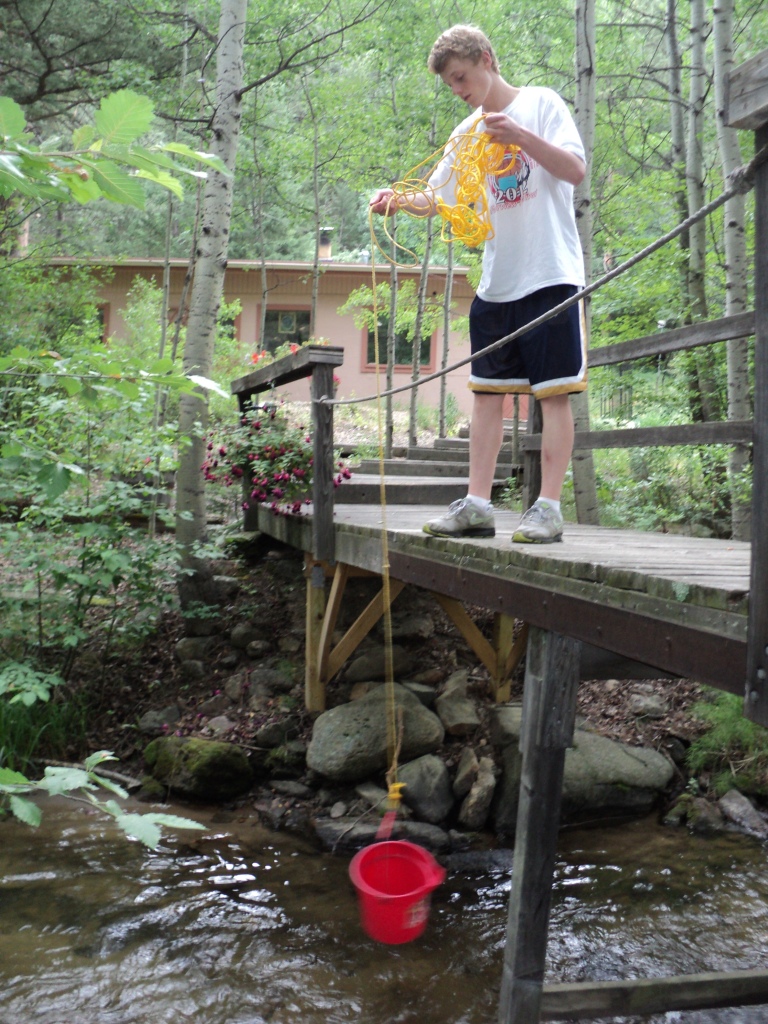
Lefthand Watershed Oversight Group!
Lefthand Watershed Oversight Group (LWOG) was chartered as a nonprofit in 2003, with goals of supporting monitoring, protection, and restoration of water quality in the mountainous portions of Left Hand Creek and its tributaries, James Creek and Little James Creek. These tributaries of St. Vrain Creek and the South Platte drain the Front Range in the vicinity of Jamestown and Ward, northwest of Boulder. Formation of this group was one of the recommendations of a Boulder County Task Force that spent two years looking into alternatives to designating the whole watershed as a Superfund site. Decades of mining for precious metals had left a legacy of acid mine drainage and metals contamination stemming from numerous abandoned mining sites.
 LWOG has worked with partners including landowners, claim owners, EPA, DPHE, DRMS, USFS, Wildland Restoration Volunteers, Left Hand Water District, Town of Jamestown, Town of Ward, Boulder County, the University of Colorado, and the James Creek Watershed Initiative to advance the goals. Numerous abandoned mine site restoration projects have been completed, and several are underway or planned.
LWOG has worked with partners including landowners, claim owners, EPA, DPHE, DRMS, USFS, Wildland Restoration Volunteers, Left Hand Water District, Town of Jamestown, Town of Ward, Boulder County, the University of Colorado, and the James Creek Watershed Initiative to advance the goals. Numerous abandoned mine site restoration projects have been completed, and several are underway or planned.To help determine the need for restoration, and to assess the effectiveness of completed projects, water quality monitoring is essential. From the start, LWOG has been involved in the River Watch monitoring program. River Watch monitoring has been supplemented by specific water-quality studies conducted by the University of Colorado.
From the data we and our partner group, James Creek Watershed Initiative, have collected over the years, we have noticed a trend toward higher pH at many stations, and lower metals concentrations. These improvements in water quality have been accompanied by the return of at least some aquatic organisms to stream reaches that previously had been barren of life. We have been able to document some improvements in water quality associated with implementation of restoration projects. We have also been able to identify some reaches that still need additional restoration and protection.
Glenn Patterson shares what he does at each site after sampling: “I have one small enjoyable add-on to the River Watch sampling routine. At each sampling site, after performing the River Watch field work, I turn over and examine up to 10 stones that I pick from the bottom of the stream, to get a quick and generalized feel for the type of benthic invertebrate community supported at that site. Occasionally no organisms are found, but usually there are at least a few, and often the stones show a reassuring abundance and diversity of benthic life.”
Glenn also adds “River Watch has given me insight into not only the month-to-month variation in pH and metals concentrations in our streams, but also the mysterious diurnal variations. As with most complex systems, the data from River Watch demonstrate a wide variety of water-quality responses, and suggest that there are no easy explanations for all the variations we see.”
Check out this map of the sites monitored by the Lefthand Watershed Oversight Group:
View River Watch Featured Groups in a larger map
Current News
- The Elizabeth McKee Foundation is generously matching each dollar donated to River Watch through December 31, 2013, up to $10,000! Help River Watch raise $20,000 and we will continue to foster environmental stewardship for many generations to come! Click here and be sure to assign your donation to the River Watch program. If you want to read more about the match, click here!
- Congratulations to Katie Kowal on being awarded the Comcast Leaders and Achievers Scholarship!
- All low-flow nutrient samples should be collected and sent to River Watch for analysis.
- Congratulations to Tayler Rocha, a student at Monte Vista High School, who recently competed in the 2012 International Science and Engineering Fair in Pittsburgh! Her project, Macroinvertebrate and Nutrient Response to Stream Water Quality after a Wildfire in Medano Creek, Great Sand Dunes National Park & Preserve, won second place in her category, as well as a Special Award from the Society for Freshwater Science! Congratulations to Tayler for her hard work!
Submit Photos of Your Group!
Do you have photos of your group? We would love to have them! If you have photos, please submit them using the form below and check back to see if your groups is featured - don't forget to include a caption!
Colorado River Watch in the News
Moving the Classroom Outdoors, Colorado Public Radio, Featuring Rocky Mountain High School
Cheyenne Creek Conservation Club, Pikes Peak Parent, Featuring the Cheyenne Creek Conservation Club at Skyway Elementary.
A Reason to Appreciate Nature, Teller County News. Featuring the Woodland Park High School River Watch group!
Colorado: Native minnows return to the Arkansas River, Summit Voice. Colorado Parks and Wildlife Biologists (BIG River Watch supporters!) restored two native minnow species in the Arkansas River.
Watershed Middle-Schoolers Monitor Boulder Creek Water Quality, Daily Camera. Featuring students from the Watershed School River Watch program!
From our volunteers
Kristal Domenico created a survey to assess Coloradoans' water knowledge. Test your knowledge here -- we expect all River Watchers to get 100%!
The students at Animas High School have conducted scientific investigations about the effects of biochar on metals in soils and plants, as well as the effect on water quality. Check out some of their work in these posters:
- Biochar Effectiveness by Metal Reduction in Leachate and Plant Growth Height as Factors of Successful Land Remediation
- The Effects of Bio-char on Concentration of Metals in Leachates of Soil Samples
- Retention of Harmful Metals in the Animas River Basin
Is high, pristine mountain water always clean and pure? The Colorado Geological Survey conducted a study last year that has since received national attention. Read the press report here, or visit the CGS bookstore to purchase "National Acid Rock Drainage Associated with Hydrothermally Altered Terrane in Colorado."





